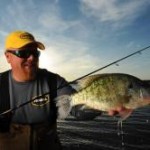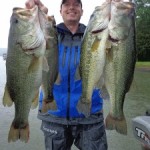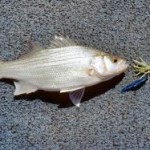Spring Crappie PANdemonium
Simple stuff for finding and fishing cool spring crappies.
By Calvin Christopher
from The Fishing Wire
Ask any saltwater angler whether ‘high’ or ‘low’ tide is the pick of the litter, and not only will you get mixed results, but iterations from “the first hour of incoming tide,” to “halfway through outgoing,” to “dead flat – I’m weird like that.”

Catch spring crappie like this
In search mode, crappie expert Brian “Bro” Brosdahl casts small jigs with soft plastic bodies. Once fish are located, he switches to fuller bodied feathered jigs tipped with minnows. Photo by Bill Lindner Photography
Maybe not quite so particular, but subjective nonetheless, are freshwater panfish seekers. And in the spring, their preferences arc the spectrum from “sun-soaked bridge pilings,” to “mouths of creeks,” to complexities like “first drops off shallow muddy bays on the north end.” Myriad factors affect their partialities, of course, things like water temperature, water clarity, bottom composition, forage base and the like. So truthfully, to offer one man’s perspective is pretty one-dimensional, given the infiniteness of conceivable factors. But what about two-dimensional? Now that’s diverse.
So unwilling to enter the third dimension, I quizzed two dogged and salty (like character; sometimes language) panfish activists for their perspectives on spring fishing. And it goes something like this:
Who is your favorite NASCAR driver?
Bro: Dale Earnhardt Jr. It’s hard to live in the shadows of a big name like his dad. Jr.’s carving his niche and I respect that. (Frankly, I thought this question would stymie Bro.)
Neustrom: Dale Earnhardt Jr. He’s the crowd favorite. Great individual. He’s gone up against all the negativity and just races fast. Oh, and Brad Kieslowski – he’s a pain in the ass, and I sort of like that, too.
Do you open with plastics or livebait on spring crappies?
Bro: For searching, it’s definitely plastics. And ice fishing sized stuff. I like to put a single Northland Bro’s Bloodworm on a Gill Getter jig. Might slide on a piece of waxworm as well. The meat and plastic combo can be lethal in the spring.
Now once I know where they’re at, it’s time for feathered jigs and minnows. Cast it out and swim it back slowly. Give fish time to come over and grab it.
Neustrom: Depends. In clear water, my tendency is to go with minnows. The bite is trickier; fish are spookier. And livebait, well, always looks like livebait. Don’t have to worry about matching the hatch.
In darker water, I catch most fish on a jig and curly tail grub. The action does it. And I’m still a firm believer in the effectiveness of vibration.
Fish under a float or cast?
Crappie warlords Bro and Neustrom underscore the importance of keeping livebait energized. Minnows are best maintained with Frabill Aqua-Life aeration systems.
Bro: I use a float when searching during bluebird days. You can work a bait so much slower under a float. No float if the conditions are perfect – low pressure, warmth and some cloud cover. Then it’s time to cast and retrieve.
Either way, I’m looking for that one fish that gives up the flock. Humminbird Side Imaging lets me choose those casts wisely, too. It’ll show me actual fish, or at the least help me identify key features like emerging weeds and sunken timber – crappies are like glue on early green weeds. And just to make sure they’re fresh, I can verify greenness with my Aqua-Vu underwater camera.
Neustrom: Both. I like to pitch and swim plastics first, though. Keep the rod tip high. Reel in slowly. And just watch and feel for the rod to load up. There probably won’t be a classic ‘bite,’ either, so be on the trigger.
I fish with a float if I’m targeting smaller spaces like pockets in the reeds. In cover, the bait needs to sit longer, let fish find it. A 1/32-ounce jig with a minnow or plastic tail works just right under a float.
Are you a slave to fishing the northwest corner of a lake?
Bro: No, not at all. Some of my best spring crappie spots are shallow weedy bays on the south end. But then I’ll check the northwest corner of the specific bay. I’d say 60-percent of my natural lake crappies are caught on the northwest corner of the most qualified bay.
And then there are all those nooks and crannies, which can be in any direction. I’m looking for harbors, channels and small sections of water that get a lot of sun but little or no wind. Crappies hate the wind.
Neustrom: No. There’s far too much emphasis put on fishing the northwest end of the lake. Instead, I choose smaller lakes with all the right stuff: reeds, bays and darker water. If it looks good, I fish it.
Weather goes to hell. Where do you start looking for bites?
Bro: Crappies will hold to structure near shallow feeding areas under cold front conditions. Or, they might hover over holes near prime shallows.
I’ll go after them one of two ways. If the fish are 12-feet or deeper, I quietly drift over them dragging feathered jigs. If they’re shallow, I’ll pitch a heavily weighted float and jig. I want the float barely sticking out of the water so waves roll over it.
For both techniques, I’m using a short, 5-foot St. Croix Panfish Series rod. Long rods catch too much wind.

Nice spring crappie
Freshwater Fishing Hall of Famer Tom Neustrom advocates releasing breeding-sized crappies before and during the spawning to promote species proliferation. Photo courtesy of Daiwa
Neustrom: I’ll slide out to first break, which might only mean 8- to 12-feet of water. Don’t expect the motherlode, but you can still pick away at a few crappies in crummy weather.
I go to a float with a plain VMC hook and a tail-hooked minnow. You have to sit on those fish.
And one more thing, I set my Humminbird on SwitchFire mode. It enhances my view, seeing baitfish and even smaller fish that’ll start me on the right path to locating larger crappies.
Led Zeppelin or the Rolling Stones?
Bro: Tough call, but I’m saying Zeppelin. The guitar riffs are epic. And their aggression and intensity keeps my pulse high, in that good sort of way.
Neustrom: Led Zeppelin. Their creativeness is incredible. Makes you stop and think.
How does current factor into your site selection?
Bro: Current sorts things out nicely. I can find fish faster. It pushes crappies into pooled-up calm areas associated with logs and timber. And the fish are usually more aggressive.
I like to tight-line with a 10-foot St. Croix Panfish Series, reaching out and bumping the jig around. And wherever possible, I lock down with a Minn Kota Talon shallow water anchor. It’s the absolute epitome of boat control.
Neustrom: Don’t like current much. Maybe the edges, but that’s about it. Crappies don’t like a lot of movement. They’re a different kind of cat.
But with all that said, current flushes in food. So it’s typical to find springtime crappies near current areas.
What are your thoughts on catch & release as it relates to the proliferation of ‘big’ crappies?
Bro: Nothing wrong with turning crappies into food, but that doesn’t mean getting greedy on the big ones. Actually, fish in that 10 to 12-inch range are the best eaters. Trust me. Watch how much better the meat cooks next time. Slabs fall apart in the pan.
And let others enjoy catching big crappies, don’t get all piggish. Unlike bluegills, there isn’t any scientific study that says fishing down size alters the gene pool. But I do know when a lake gets hammered, it takes years to bring back size.
Neustrom: I really don’t like catch and kill during the spring spawn. Let them breed. And if you remove the large fish, eventually all you’ll have are dinks. Can take 4- to 6-years for size to recover. I’ve seen it over and over again.
Where did all the big ones go, people ask? Duh.




